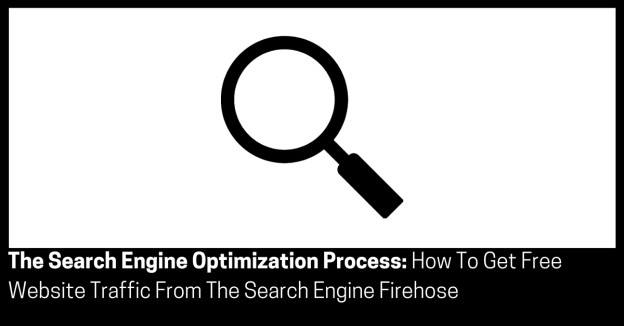Approximate read time: 23 minutes
North Americans make 20.3 billion searches in one month.
That’s a lot of searches and indicates that search is a big digital activity.
In fact, according to Alexa.com, Google is the most visited site in the world.
Google has 68% market share of all search queries, followed by Bing at 27%.
With this context, you can see that search engines are a firehose for traffic.
However, not too fast…
Marketing on search engines, which is also known as Search Engine Optimization or SEO, is not for every brand.
So what types of brands can benefit from SEO then?
- Brands whose target market uses search engines – SEO only matters if your market is using search;
- Brands whose target market uses search engines in significant volume for return-on-investment in time, labour and money compared to other marketing channels; and
- Brands whose relative competition density makes it easy to rank for return-on-investment in time, labour and money compared to other marketing channels.
There are two main types of traffic that SEO can generate.
In addition to organic traffic it can generate for brands via the Search Engine Results Pages (SERPs), direct traffic can also be generated by building links, a concept we will cover later in this guide.
And as well we’ll discover, there is a synergy between many other marketing and sales strategies, such as:
- Content Creation (and distribution)
- Publicity;
- Social media; and
- Partnerships.
So, what is SEO then?
Let’ start with some definitions.
Optimization is defined as the act, process, or methodology of making something as effective as possible.
In the context of SEO, optimization is defined as the act, process, or methodology of making your website’s ranking as effective as possible, meaning that is ranks on the SERPs for the keywords your target market is searching and thus you want to be visible for.
Here are the simple steps people take when they use search engines:
- They have a need for information;
- They type a keyword query in a search engine;
- They browse the search engine results for relevant information;
- They click what they think is best matching information;
- They scan that website for relevant information; and
- They repeat Steps 2-5 if necessary until they find the information they need.
Let’s explore these in more detail…
People are in pain and get out of that situation.
They go to a search engine to find information to get them out of pain and move towards gain.
That could be:
- Information in the strict sense of advice; or
- Information in the sense of a sales pages for a products, service or solution.
A search engine is internet software that searches for entries in a database that correspond to search terms (or keywords) entered by a user.
Simply, entries in a database are all websites on the internet.
The user enters keywords related to what they think will solve their pain or gain into the search engine, hoping the search engine will understand their pain and gain by interpreting their intention from the keywords and return them the most relevant (and related ) information that matches their query.
The user browses the SERPs results (There are ten positions per page which are ordered by rank relevancy) hoping to find the information search links they think will help them the most, in other words, the most relevant results.
Of course, ideally in the number one search result.
Position one receives more traffic than two and position two receives more traffic than three and so on.
They will then skim, not read that page to confirm it is as relevant as it said it was.
In other words the trail is the same on the SERP as it is on the page.
If after scanning the page, it is not relevant, they will repeat until they find what they need.
It is the search engine’s job to reduce the amounts of repeats.
Why is relevancy important?
If the search engines returned irrelevant information, then the user wouldn’t find value in the search engine, because it’s is time consuming and not helpful for solving their pain or gain.
Therefore relevance is judged by users.
This includes things such as page load speed, duplicate content, comments, and links to it, which we will cover later in the guide.
It’s the search engine’s business model to help people get the information they need for their pains and gains.
How do search engines work?
In terms of SEO, the internet is made up of:
- Information rich content, also known informational content; and
- Links between Information.
That is why it is called the inter-net, an inter-network of information (hosted on computer servers) and links between that information (hosted on computer servers) and other information (hosted on computer servers).
While we are here, let’s define what content is.
Content could be defined as creating and distributing consumable information that is expressed through a medium, such as text, images, video, audio and so on.
Taking this concept further, content in the context of marketing and sales is creating and distributing content that is useful to your prospects and customers and to generating leads and convert them to sales.
Search engines try to find all the content that exists on the internet by bots, which are software that crawls website for informational content via links.
Once found, search engines then create an index in a database for searching and try to make sense of it by giving users is the most relevant information (many ranking factors and popular).
This helps with quick search results.
Of course, as search engines and their bots are software-based they cannot understand the information they find in the same way as a human can, so how a webpage is setup, in terms of its software code, helps the search engine determine its relevance.
The search engines have many algorithms for what matters, bounce rate, links, but no one will ever know as they are not disclosed.
If you think about how users naturally want to find information and the business model of search engines, then you will get a good idea of what the algorithms may look like.
Here are the elements:
- STEP 1: SEO Research;
- STEP 2: Current Analysis;
- STEP 3: Keyword Testing;
- STEP 4: Website Architecture;
- STEP 5: Internal Content Creation;
- STEP 6: Internal Content Architecture;
- STEP 7: Internal Content Distribution;
- STEP 8: Internal Content Submission;
- STEP 9: Internal SEO Metrics;
- STEP 10: External SEO Partner Research;
- STEP 11: External SEO Partner Outreach;
- STEP 12: External Content Creation;
- STEP 13: External Content Distribution; and
- STEP 14: External SEO Metrics.
Steps 1 – 9 are what are commonly referred to as on-page optimization.
Steps 10-14 are what are commonly referred to as off-page optimization.
By understanding SEO, brands can do many things to help them appear on the first page of the SERPs.
Let’s begin with…

1) SEO Research
…This step is about SEO research.
SEO research is important because it allows you to:
- Determine a return-on-investment in terms of traffic generation; and
- Determine if SEO is right for your brand.
The first part is to determine the quantity of searches for keywords on search engines.
This is based on:
- The keyword terms you want to be ranked; and
- The quantity of search traffic for those terms.
Keywords could be searched in the following ways:
- Broad match – this is the default match type including misspellings, synonyms, related searches and other relevant variations;
- Phrase match – this is based on the keyword phrase and any close variations of that phrase as searched with quotation marks: “ ”; and
- Exact match – this is based on the exact keyword term or phrase and any loose variations of that exact term as searched with square brackets: [ ].
Next, you need to determine the level of competition for the keywords that are important for your brand to be ranked for.
This could be the amount of pages that are index in the search engine for that term.
Finally, you need to select keywords you want to be ranked for those that have high traffic but low competition.
Of course, the exact details of how to do this are beyond the scope of this guide.
This leads to Current Analysis…

2) Current Analysis
…This step is about where your website currently ranks on search engines for certain keywords.
Analysis of current ranking is important because it gives you a benchmark to calculate your return-on-investment and your progress on the search engine results pages.
So, you need to find where your website ranks for your selected keywords in the previous step.
Of course, the exact details of how to do this are beyond the scope of this guide.
This leads to Keyword Testing…

3) Keyword Testing
…This step is about testing your selected keywords.
SEO generates traffic, but more importantly, a lead generation activity for your brand.
This means you want to be effective in lead generation.
Marketing is generating leads, as opposed to sales which is converting leads to sales or prospects to customers.
In other words, you only want to rank for keywords that have high search volume and low competition with other websites, as explained previously, but also for those keywords that convert to leads.
There is no point ranking for keywords with high search volume and low competition if they don’t convert to leads.
Keyword testing is important because there is no point putting effort into optimizing for keywords that don’t generate leads.
Put another way, if you optimize for keywords that rank well but they don’t convert to leads, that effort is wasted.
In addition, SEO and ranking for keywords takes time.
If it was easy and quick, then any brand could manipulate the search engine rankings and results pages and appear in the number one search results spot.
Search engines don’t want this to happen as it will affect relevancy for they users.
So you need to determine the effective keywords to target and only optimize for those.
One of the best ways to do this is by purchasing search engine advertisements (also known as Search Engine Marketing or SEM) for the same keywords you want to rank for and measure what converts best.
Then once you know which keywords they are, continue the SEO process so you can start generating leads via SEO for free in the future instead of purchasing search engine advertisements.
And as you can guess, this step is optional for this reason.
Of course, the exact details of how to do this are beyond the scope of this guide.
This leads to Internal Website Architecture…

4) Website Architecture
…This step is about planning and implementing website architecture.
Architecture is the design of buildings, whereas Website Architecture could be defined as the design of websites.
Website architecture is important because the design of websites should be optimized for search engines to be able to easily find the information content on it to determine if it is relevant to users searching for keywords.
The factors that help search engines read websites:
- Site maps; and
- Physical and virtual siloing and internal link structure.
This step is repeated indefinitely, as you always need your website to be optimized for search engines to be able to easily find the information content.
Also, continuously test to see how search engines see your webpage and then include fixing issues as new content is published.
Of course, the exact details of how to do this are beyond the scope of this guide.
This leads to Internal Content Distribution…

5) Internal Content Creation
…This step is about creating content for your website.
Creating internal content is important because your website needs content to tell search engines what your website is about so it can be relevant to users.
Content that is published on your website is indexed by search engines.
Search engines are particularly interested in keywords and keyword density of that information on your website, because this is related to users’ pain and gain when they search.
Keyword density is defined as the percentage of times a keyword appears on a web page in relation to the total word count.
Content keywords should be related to what keywords you want to be ranked for.
It should be original and not duplicate any other written content.
Duplicate content is as it sounds – substantial similar written text found on multiplied websites.
Duplicate content can be seen as a way to create indexable content and links in an attempt to affect SERPs and website that do it are punished by search engines.
You have two options for content:
- Create it; or
- Curate it.
My guide on The Content Creation Process tells you how to create content.
This step is repeated indefinitely as you always need relevant information on your website.
Of course, the exact details of how to do this are beyond the scope of this guide.
This leads to Internal Content Architecture…

6) Internal Content Architecture
…This step is about planning and implementing content architecture.
Content Architecture could be defined as the design of content on a website.
Internal content distribution is important because, like internal content creation, you need content to tell search engines what your website is about so it can be relevant to users’ pains and gains.
Content architecture is important because it is the design of individual content on websites to be optimized for search engines.
The factors that help search engines read content are similar to website architecture:
- URLs and domain name;
- Title tag, H1 and body tags;
- Content Keywords, meta tags and descriptions;
- Image alt text;
- And so on…
These all have maximum lengths.
This step is repeated indefinitely as you always need relevant information on your website.
Also, continuously test to see how search engines see your webpage, including fixing issues as new content is published.
Of course, the exact details of how to do this are beyond the scope of this guide.
This leads to Internal Content Distribution…

7) Internal Content Distribution
…This step is about distributing you content internally.
Internal content distribution is important because this step allows your content to be published internally to be optimized for search engines.
This means publishing on your website.
This step is repeated indefinitely as you always need relevant information on your website.
Of course, the exact details of how to do this are beyond the scope of this guide.
This leads to Internal Content Submission…

8) Internal Content Submission
…This step is about submitting content to search engines.
Submitting your internal content is important because if search engines do not know about your website and its related information content, then they cannot serve the webpage and information content up to users who are searching.
This step is optional if your site is already indexed by the search engines.
Of course, the exact details of how to do this are beyond the scope of this guide.
This leads to Internal SEO Metrics…

9) Internal SEO Metrics
…This step is about measuring on-page factors that affect SEO.
On-page metrics are important because they help tell search engines that your website is user friendly.
Factors that search engines take into consideration for on-page measurements are as follows:
- Page load etc. from images;
- Bounce rates;
- Time on page;
- Return users;
- Pages per visit;
- And many, many more…
These all indicate the relevance of your internal content.
If you get any negative results, you need to fix them.
This is an ongoing monthly task.
Of course, the exact details of how to do this are beyond the scope of this guide.
This leads to External SEO Partner Research…

10) External SEO Partner Research
…This step is about researching relevant external websites for potential links to your website.
Website link research is important because search engines count links to your site from relevant external sites as a factor in popularity and relevance for related information keywords.
This could be based on:
- The quantity of links from unique domains;
- The quantity of links from one domain;
- The quantity of pages on domain;
- The quality of the website that links; and
- The quality of the content on those domains.
At this step, you need to find and document (including their contact details) all sites relevant and related to the keyword you want to be ranked for.
Next, you want to rank these websites in priority order of whom you will approach with outreach (discussed later).
These sites should have the following SEO factors:
- Authority;
- Trust;
- Relevance; and
- Link popularity.
Then, you want to list what types of content they have on their sites and what is more important to your brand.
This is because in the next step you will be offering them a very specific type of content incentive.
Not all links are of the same value; for example, a link from a comment section on a blog doesn’t have the same value as a link from a news site.
This will give you an initial approach order.
Of course, the exact details of how to do this are beyond the scope of this guide.
This leads to External SEO Partner Outreach…

11) External SEO Partner Outreach
…This step is about reaching out to websites you researched in the previous step to ask for links.
Outlet link outreach is important because search engines count links to your site from relevant external sites as a factor in popularity and relevance for related information keywords.
In essence, this outreach is a sales script.
The goal of external SEO partner outreach is to get links…
In essence, you want a link, but a link that also has:
- Link anchor text related to your keyword;
- Link anchor text that is dynamic and not the same as all the rest (this indicated manipulation);
- A link that is surrounded by keywords and information content; and
- A “follow” link.
There are too many examples of links to list in this guide, but the following categories are useful to differentiate between the types of links you could get:
- Outreach – Content & Links;
- Outreach – Links only (Social media sharing);
- Your external web properties – Content & Links;
- Your external web properties – Links only;
- Content Submissions – Content & Links;
- Content Submissions – Links only;
- Paid – Content & Links;
- Proactive External – Content & Links; and
- Ad hoc – Content & Links.
Some of these are ongoing, others are once-off like setting up your social sites.
As mentioned previously, you will be offering another website a very specific type of content as an incentive for a link back to your website.
You want to appeal to their self-interest.
The way you will get a link is by providing them with content.
Content creation takes time and labour or capital, so you want to explain that you will make it easier for them by you giving them content.
You need to explain why it is useful to them.
The hook is:
- Content takes time and effort to create;
- But content is really valuable for their brand;
- Let you do all the content creation for them; and
- You’ll make it easy for them.
You will deliver this to all your partners on a regular basis.
You need to work out what format the content is.
You need to appeal to the audience’s interests, but if you have done your outreach research well, these sites will be relevant to you as there will be a natural overlap.
You need to write the outreach and send it.
You will offer the following content incentive for a link back to your website:
- Ongoing content package with descriptions for that keyword and niche (will discuss later).
Your Content Pack will consist of the following:
- Process map;
- Mind map (if applicable);
- Infographic;
- Audio;
- Video;
- Slide-deck;
- And so on…
Search Engine duplicate content rules do not apply to any of these medium, even though it is technically duplicate content.
Duplicate content only related to the text.
In addition to this, you will provide the following promotional tools, to increase the likelihood of links:
- A banner;
- A link to site;
- Free hosted content;
- Promotion text;
- Accompanying text suggestions; and
- HTML source code for each content element.
Of course, the exact details of how to do this are beyond the scope of this guide.
This leads to External Content Creation…

12) External Content Creation
…This step is about creating content for external websites.
Creating external content is important because search engines count links to your site from relevant external sites as a factor in popularity and relevance for related information keywords.
This content will then be distributed to SEO content partners.
Again, search engines are particularly interested in keywords and keyword density, because these are what are related to pain and gain searches.
External content keywords should be related to what keywords you want to be ranked for.
Again, it should be original and not duplicate any other written content.
Likewise, you have two options for content:
- Create it; or
- Curate it.
Now that you have researched relevant websites and reached out to them, it is time to create content for them based on the promise of the content pack.
But I will discuss how External Content Creation is different to Internal Content Creation.
You want to be creating scalable content.
Scalable, as opposed to modular, means servicing one or 100 SEO content partners takes the same effort.
Before you freak out, the most scalable way is to translate the Internal Content you created in Step 5 into the various modalities you promised in Website Link Outreach.
This means you create one version for your website, but you create multiple other versions of the same content, but in different modalities of other websites which are not punishable by search engine duplicate content rules.
In other words, you want to create external content once (and quickly), send to multiple and get multiple links that are not punished by search engine duplicate content.
A unique approach to External Content Creation that allows you to appeal to SEO partners’ self-interest is a case study of them, which you send to them and they are more likely to publish.
This is not scalable.
And it’s only worthwhile doing once-off content for big or authoritative outlets that can provide quality links and direct traffic.
This step is repeated indefinitely as you always need relevant information on your website.
Of course, the exact details of how to do this are beyond the scope of this guide.
This leads to External Content Distribution…

13) External Content Distribution
…This step is about distributing the content you created externally to your SEO link partners.
External content distribution is important because this step allows your content to be published externally and thus generate links back to your website.
Give partner the conditions for use.
This could be:
- They must provide a follow link to your website;
- They must attribute the copyright for it to you;
- You host files on their behalf;
- And so on…
If one of the conditions is that you will host the content (video and audio files can be large) on your server, you need to give your partners the embedded code for the content.
Alternatively, simply given them the content to download and self-host.
The means sending your SEO link partners the content you created in your Content Pack via any of the following distribution means:
- An RSS feed;
- A downloadable zip file;
- Email with links;
- And so on…
Once they have your content, then they have a few sharing possibilities.
They have three options with content:
- Share the content with a link a link to your original content(usually via social media);
- Embed the content with some new content with a link as credit; and
- Create their own content with a link as a mention.
Of course, SEO partners will pick what is most suitable for them.
That is why providing multiple modalities of the same content is important – it increases your changes chances of content being published and therefore more links to your website.
So from one bit of content on your website, translating it to multiple modalities gives you several links:
- From external social platforms; and
- From external partners website.
The latter being the most valuable link.
Remember you will also be sharing the content to your mini sites and social platforms.
If they do not want to post the Content Pack on their website, then you need to give them any promotional text for link-only promotion in another way, such as via their social media platform.
If they want to post the Content Pack on their website, then you need to give them the on-page text suggestions.
It’s best to do this in dot form, so you provide them with a foundation.
To help their pages index even more effectively beyond the Content Pack, encourage them to write text to accompany this content.
This is because images, audio, video, slide-deck and are not text rich by themselves and will not index very well.
Remind them that search engines’ duplicate content rules do not apply to any of these medium.
Writing accompanying text will index the content, even it is only 500 words.
500 words is a small blog post, so the Content Pack will pad out the page to make it look really impressive to their audience.
To help save them time give them the dot points to summarize the contents topic.
All they have to do is elaborate on them and post – simply elaborating 50 words for ten dot points will give them 500 word text for the blog post in addition to the other content elements.
In other words, you’re offering them a free “mini guest post” to go along with the Content Pack.
If you distribute one content pack a week to just ten partner sites, you could get up to 520 evergreen posts and links per year, including 1040 other links for a total 1560 links.
That’s a lot of links for creating just one bit of original content per week!
Of course, the exact details of how to do this are beyond the scope of this guide.
This leads to External SEO Metrics…

14) External SEO Metrics
…This step is about measuring external factors that affect SEO.
External SEO metrics is important because they help tell search engines that your website is popular.
Popularity is another way of saying “votes” by links to your website from relevant and related websites.
Factors that search engines take into consideration for external metrics are as follows:
- The quantity of links from unique domains;
- The quantity of links from one domain;
- The quantity of pages on domain;
- The quality of the website that links; and
- The quality of the content on those domains.
This is an ongoing monthly task.
Of course, the exact details of how to do this are beyond the scope of this guide.

Take Action
You’ve made it…
You now have a solid plan for SEO.
That’s the full Search Engine Optimization Process, and it will be more than enough for you to get started on your own.
You can get the printed illustrated Process Map of this and 20 others for free, here
And if you’re serious about marketing and selling more, the logical next step is to contact me to help you do it yourself, have me do it with you, or have it all done for you.
This maybe the momentum you need to get great marketing and sales results.
Now let’s learn about The Positive Publicity Process.
Or do you simply want more like this?
Join below to be notified immediately about new content and more. No annoying daily emails and no spam – just good content when it’s posted.


Excellent article – very informative, well-written and easy to follow. Thanks, Orren!